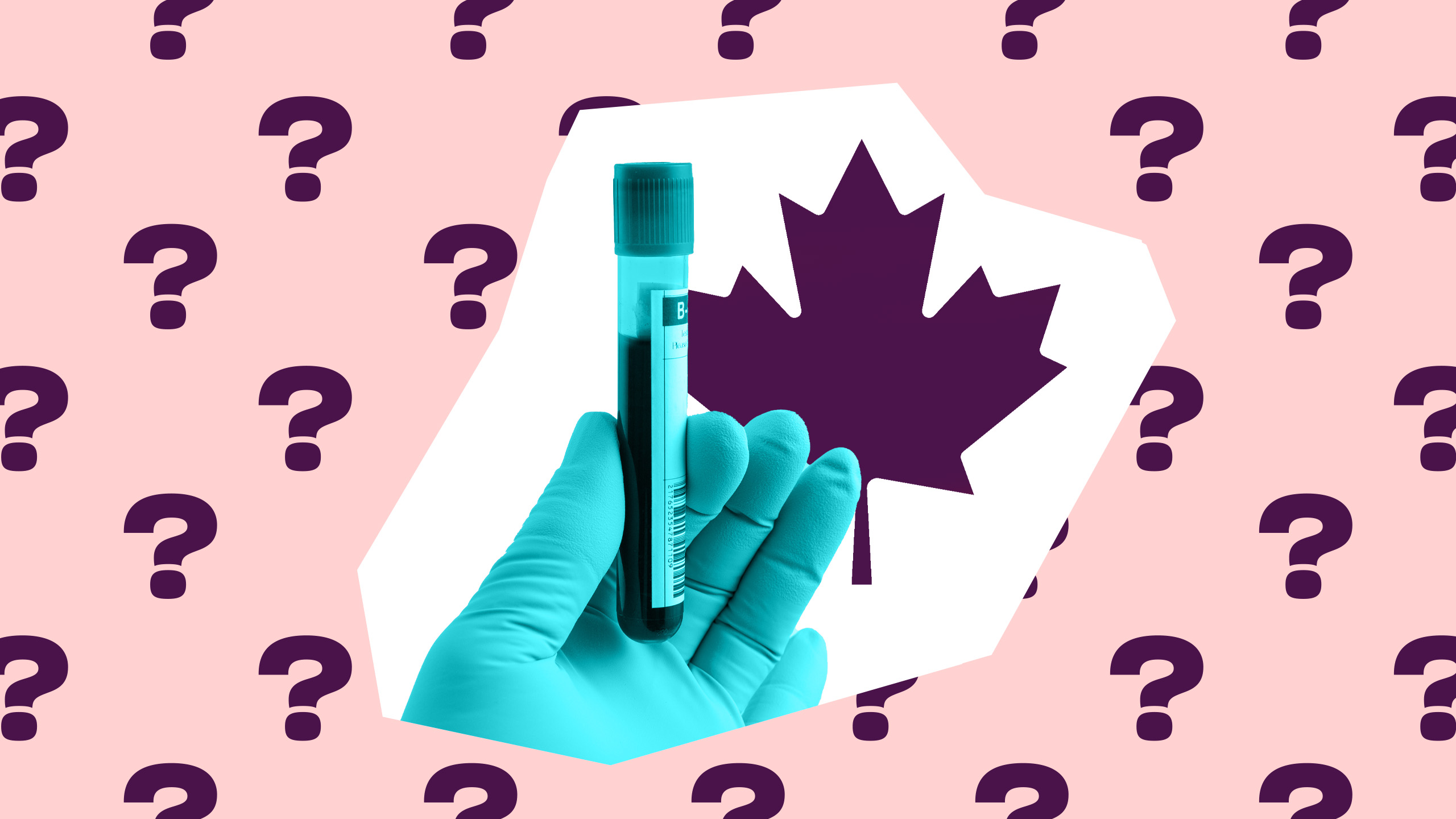In April 2022, Canadian Blood Services made historic changes to its eligibility criteria, removing a three-month deferral period on blood donations from gay and bisexual men, as well as from some others in the LGBTQ2S+ community. Since September, all prospective donors—regardless of sexuality or gender—are now asked whether they have had sex with multiple partners in the last three months. They may also get asked if they’ve had anal sex, if they’re living with HIV, if they have had sex with someone who’s living with HIV, if they are a sex worker or if they are on PrEP.
Rules on who can donate blood in Canada have slowly changed over time. After Canada’s Tainted Blood Scandal in 1992, Canadian Red Cross (which later became Canadian Blood Services) introduced a lifetime ban on blood donation for men who have sex with men. Activists have steadily fought to make the policies less discriminatory over time. The U.S. is currently considering adopting similar rules.
While many media headlines celebrated the latest changes to Canada’s blood donation policies as “the end of the blood ban,” advocates say the changes still reject and stigmatize parts of the LGBTQ2S+ community. We talked to University of Victoria professor Dr. Nathan Lachowsky, research director at the Community-Based Research Centre, about how these changes fall short and what still needs to be done.
After the most recent round of policy changes this year, nearly every headline seemed to imply the blood ban was over. How accurate is this?
It’s definitely true in some sense. For decades, we had a ban specifically preventing men who have sex with men from donating blood. And so the change that really everyone is talking about is the move to a gender-neutral approach. I think the other thing is that historically, we’ve had many different screening questions that deterred people from donating who are part of many different queer communities. It’s important that we celebrate that because the MSM policy was problematic, in that it treated any sex between men the same way; it was also problematic because it really did impose this gender-binary system, which made it difficult for trans folks and non-binary folks to navigate the system.
But the blood ban goes beyond screening questions. For instance, Blood Services will still use an international software system that only has male or female designations. That means non-binary people will still have to be entered into the system as either male or female, for example. So it’s not like every issue is necessarily solved with a change in policy.
My main message is that we should celebrate, because this year’s changes do recognize the years and years of advocacy work and research work. But the fight is certainly not over.
So who exactly is still barred from giving blood?
Any donor, regardless of their biological sex, gender identity or relationship structure, is asked whether they’ve had a new sexual partner in the last three months, or if they’ve had multiple sexual partners in the past three months. If you haven’t had a new sexual partner in the last three months, or you have only had a single sexual partner in the last three months, then you won’t be asked about anal sex. If you have multiple sexual partners, or a new sexual partner, then you will be asked if you’ve had anal sex with any of those partners, and if you have, then your donation would be deferred by three months.
We know that anal sex is most common amongst gay men and other members of the LGBTQ2S+ community—but we also know that that many other people have anal sex. We know anal sex has a higher likelihood of transmission of HIV than other forms of sex that people can have. And so that’s part of why the focus is no longer your gender or your sexual orientation or even your biological sex, really. All donors are asked if they’ve had multiple partners, or anal sex with those partners. And then if they say yes to either of those questions, they’ll get asked if they’re living with HIV, if they have had sex with someone who’s living with HIV, if they are a sex worker or if they are taking PrEP. All of these are grounds for a deferral. So there are still a lot of parts of our community that aren’t able to donate.
How could these questions and policies be further changed to help with that?
There are many places where we can still make changes. And it’s important that it’s not just for the sake of anti-discrimination and anti-stigma. This is also about creating a safe blood supply, where we can have sufficient blood available for any of us who need it. We know that lots of people in queer communities need blood and it’s not like these are exclusive communities, either. There are hemophiliacs who are bisexual men, for example. And at the end of the day, we want to make sure that there’s safe and sufficient blood available for any of us whenever we need it.
What could a sufficient, medically accurate de-stigmatized system look like?
To me it’s about looking at [whether] all of these new questions are fully necessary? Are any of them redundant? Sometimes we might have multiple questions that are getting at the same thing, for instance, asking redundant questions about previous sexual partners in addition to questions about sex work. So that’s definitely one place to start—are there some questions we could reduce or remove?
Then we have to have more specificity. For instance, we know that HIV-positive people with undetectable viral loads are unable to transmit the virus, but our deferral policy doesn’t reflect that. We also don’t ask any questions about condom use or protection, which are very important factors.
There’s also a possibility that we can reduce the period of time people are turned away for. I think those are kind of the frontiers where advocacy needs to continue. The big thing I’ll say is, it’s important to remember that white gay men are one part of the LGBTQ2S+ community, but the people who are deferred in this policy are not just white gay men. We also have deferrals around sex work, we have deferrals around injection drug use, we’ve had deferrals for living with HIV. And so we need to really think intersectionally. Who is going to benefit and be able to donate, and who continues to be marginalized and excluded from the system? And again, the key thing is making sure that people who would be safe donors are able to donate, because that’s integral to making sure people can get what they need in terms of blood products.
How much is systemic queerphobia an obstacle to these changes, and how will advocates navigate that?
I think that it’s broader—in some ways it’s just about sexual stigma. To me, it’s okay if people feel some discomfort in the blood donor process … if people feel a bit of discomfort being asked about things like condom use, that’s okay—it’s in the name of science and safety. It’s better for us to ask something specific than it is for us to kind of gloss over and say, “Oh, you’re a man who has sex with men, and I don’t want to know any details about the kinds of sex you have.” In reality, not all sex is created equal in terms of HIV transmission. So I think that specificity part is hard because we’re pushing against actual sexual stigma and conservativism. But as we create a better and clearer rationale about why we’re asking certain questions during the screening process, science will benefit the advocacy because our advocacy is evidence-based.
At the same time, we need to acknowledge the intersection with racial and other forms of discrimination. We’ve had bans in place against certain African communities, for instance. So we can’t just change a policy, and then do nothing else to repair the harm that was caused for years and years. We’re not operating in a neutral space. We need to think about what else needs to be done at a societal level, to make sure that the damage that was done through stigmatizing people unnecessarily for years is reversed.
What are the next steps for LGBTQ2S+ allies and advocates?
In some way, the media created this narrative that the ban is over. And as I said before, it’s really not. There’s still lots left to be done, and it’s important that those of us who can donate now don’t stop caring about this issue. Solidarity within our community and across communities is important now more than ever, because it’s really only through that pressure, that we get the necessary scientific research, apologies and policy changes to happen. It took time and effort to get to where we are now. So we should celebrate. But it’s just one milestone in a very long marathon that is going to continue for many, many years.
If you have any questions about the new policy, or want to share your experiences donating blood, please visit CBRC.net to share your insights with researchers and advocates like Dr. Lachowsky.


 Why you can trust Xtra
Why you can trust Xtra


